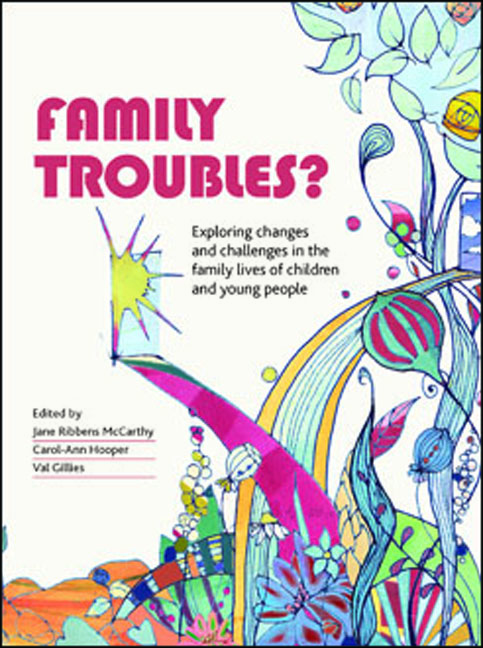Book contents
- Frontmatter
- Contents
- Notes on contributors
- Foreword
- Preface
- 1 Troubling normalities and normal family troubles: diversities, experiences and tensions
- Part One Approaching family troubles ? Contexts and methodologies :Introduction to Part One
- Part Two Whose trouble ? Conteste d definitions and practice: Introduction to Part Two
- Part Three The Normal, The Troubling And The Harmful?: Introduction to Part Three
- Part Four Troubles and transitions across space and culture: Introduction to Part Four
- Part Five Working With Families: Introduction to Part Five
- Index
Part Three - The Normal, The Troubling And The Harmful?: Introduction to Part Three
Published online by Cambridge University Press: 07 September 2022
- Frontmatter
- Contents
- Notes on contributors
- Foreword
- Preface
- 1 Troubling normalities and normal family troubles: diversities, experiences and tensions
- Part One Approaching family troubles ? Contexts and methodologies :Introduction to Part One
- Part Two Whose trouble ? Conteste d definitions and practice: Introduction to Part Two
- Part Three The Normal, The Troubling And The Harmful?: Introduction to Part Three
- Part Four Troubles and transitions across space and culture: Introduction to Part Four
- Part Five Working With Families: Introduction to Part Five
- Index
Summary
While the potential for harm to children and young people, sometimes along with other family members, in a range of family troubles is a theme throughout this book, Part Three illuminates some of the complexities of identifying those who are particularly vulnerable. To a large extent, families construct their own version of the normal, and children and young people may be unable to detach sufficiently from the power and significance of the relationships on which they depend to perceive alternatives and name their own experience as harmful (see the chapters by Mannay and Wilson). Whether particular troubling events or experiences create lasting harm is also influenced by many aspects of their context: relational, social, material and cultural (see the chapter by Jamieson and Highet and the chapter by Davies). Furthermore, emotions within family relationships are complex – involving love and hate in all families, as well as the intensified anger, shame and guilt associated with abuse or neglect – and the expression of aggression may be creative as well as destructive (see the chapter by Lucey). Different figures are cited to draw a boundary around the troubled – the UK government's Troubled Families Unit identified 120,000 ‘troubled families’ in 2011, while a year later, after the discovery that young people involved in riots in the summer of 2011 did not predominantly come from those families, a further 500,000 ‘forgotten families’ were named. Both groups have focused largely on the poor and marginalised, but harmful troubles are potentially much more widespread and not confined to families who ‘bump along the bottom of society’ (Riots, Communities and Victims Panel, 2012, p 7).
Exposure to domestic violence (the subject of Dawn Mannay's chapter) is associated with an increased risk of all forms of child maltreatment and is now recognised as a form of emotional abuse of children itself in the UK (HM Government, 2010) – a recent survey found that over a quarter of 18- to 24-yearolds reported experiencing this at some point in their childhoods (Radford et al, 2011). The number of children living with parents misusing drugs (the subject of Wilson's chapter) was estimated by the Advisory Council on the Misuse of Drugs in 2003 as between 200,000 and 300,000 children in England and Wales (2–3% of all children under 16) and may well have increased since.
- Type
- Chapter
- Information
- Family Troubles?Exploring Changes and Challenges in the Family Lives of Children and Young People, pp. 131 - 134Publisher: Bristol University PressPrint publication year: 2013
- 1
- Cited by



